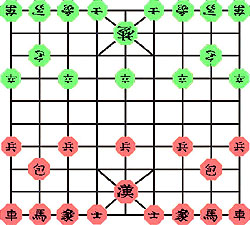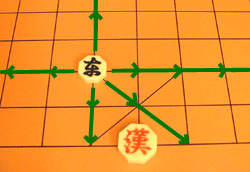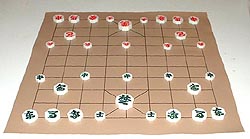| |
|
An Illustrated History of Chess_________________6____
Ooops
— did
I say something a little different? This diagram looks
terribly similar to the Chinese chess we were just discussing.
But
look more closely!
There is no river in the middle of the board;
the pieces are octagonal, not round;
the characters on the red side are similar to the Chinese pieces,
but totally different on the green side;
the board is stretched a little left to right;
some pieces are larger than others; and
the commander (king) starts out on the second row.
|

the initial array of janggi |
|
What
we have here is Korean chess — janggi.
 It has also
been written changgi, jangki, and even (as per Murray)
tjyang keui... because it's taken so long to agree on how
to transcribe Korean into English!
It has also
been written changgi, jangki, and even (as per Murray)
tjyang keui... because it's taken so long to agree on how
to transcribe Korean into English! |
If you
compare the rules of xiangqi (Chinese chess) with janggi (Korean
chess), you'll find some rather peculiar differences.
In fact, the moves of the commander, advisors, elephants/ministers,
cannons and pawns are all significantly different from the corresponding
pieces in the Chinese game. |

the Chinese (xiangqi) pieces, compared to...

...the Korean (janggi) pieces.
Note the similarities and differences. |

the elephant's move in janggi
|
It's not nice to pick on elephants, but here, once again, one
of the most peculiar aspects of the game is raising it's tusk-
bearing head to be scrutinized. It's true: this is perhaps the
most peculiar move to be found in any long-standing chess tradition.
The
fact is the Korean elephant moves one space (or one point)
front, back or sideways, plus two spaces diagonally.
Just as the Chinese elephant is a logical extension of the advisor's
move, the Korean elephant is an extended horse's move.
|
Here
is another rather special thing about Korean chess. Remember that
"X" in the middle of the board which indicates the general's
fortress, both in Chinese and Korean chess? Well, in the Korean
game, the lines which form the "X" affect the moves of
the pieces.
According to the Korean sensibility, pieces which move along the
horizontal and vertical lines of the board (i.e., the rooks,
pawns, canons advisors and generals) should also be allowed to move
along any line which is printed on the board — including
the diagonal lines within the fortress. You can imagine
how this wild expasion of moves heightens the drama of attack when
enemy pieces enter the general's private chamber! |

The rook moves not only horizontally and vertically — as
it does in other forms of chess — but also along the diagonal
lines within the fortress. |
If you are intrigued by the peculiarities you see here, I recommend
that you take a look at the rules
of janggi. Some of the conventions of this game are actually
older than the modern Chinese game, such as the starting
position of the general (king), and the 9 x 10 point board,
without the Chinese river. Other rules, like the ones
shown above, are newer — rather quirky — innovations.
You
may find that, as we take our survey toward the East, the forms
of chess we find are ever more foreign and strange to our western
eyes. But we have just one more eastward step to take...to the
most complex chess form of them all! Let us complete our journey
at the Land of the Rising Sun with shogi, the chess
of Japan!...
<<Previous
Page ... Next Page>>
|
__
|
|






